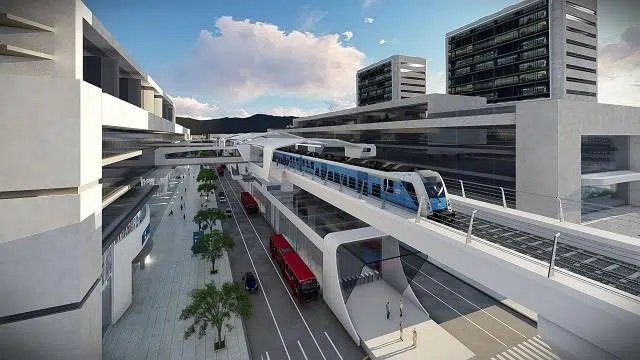
- China’s presence in Latin America is growing with a new focus on Chinese investments in Colombia.
- How Chinese investments in Latin America compare with U.S. investments in the region.
- The U.S. response to this new dynamic.
Latin America has long been an economic backyard of the United States, but in recent decades, it has experienced a significant shift in its economic dynamics. China, with its growing global influence, has intensified its investments in the region, challenging the traditional economic supremacy of the US.
Colombia, a strategically important country in Latin America, has not been exempt from this trend, and Chinese investments are leaving their mark on its economy.
China’s Footprint in Latin America
China has shown significant interest in Latin America over the past two decades. The Asian giant has invested billions of dollars in the region in various areas, from infrastructure to energy and mining. A report by the Inter-American Development Bank (IDB) indicates that Chinese investments in Latin America increased from around $2 billion in 2005 to over $30 billion in 2019. These numbers reveal a serious commitment by China to the region.
This investment has translated into job creation and infrastructure development across Latin America. In the energy sector alone, China has invested over $16 billion in electricity generation projects, helping to provide power to millions of households in the region.
In contrast, U.S. investments in Latin America have decreased in relative terms. Despite being the region’s top trading partner, the presence of the United States in terms of foreign direct investment (FDI) has gradually declined. According to World Bank data, U.S. investments in Latin America have gone from representing 20% of total FDI in the 1990s to 12% in the last decade. This has led some to speculate whether the United States is losing ground to China in its own neighborhood.
Chinese Investments in Colombia
Colombia, as one of the largest and most dynamic economies in Latin America, has been a focus of attention for both China and the United States. China has been actively involved in the South American country, with investments spanning multiple sectors.
One key area where China has invested in Colombia is infrastructure. Large-scale projects such as road and bridge construction have been financed by Chinese companies. A notable example is the Bogota-Girardot highway, built by China Harbour Engineering Company (CHEC), which has significantly improved connectivity in the country. The investment in this highway reached $2.5 billion.
Additionally, China has invested in Colombia’s energy sector, participating in the construction and operation of hydroelectric projects. The Hidroituango project, for instance, features Chinese investment of over $1.5 billion and is one of the largest energy generation projects in Colombia.
Another sector where China has increased its presence is telecommunications. Technology company Huawei has played a significant role in expanding telecommunications infrastructure in Colombia. This has raised concerns in some sectors about information security and the reliance on Chinese technology in critical infrastructure.
Bogota Metro

Perhaps one of the most significant Chinese investments in Colombia at the moment is its involvement in the construction of the Bogota Metro. In 2019, the city awarded the construction of the long-awaited first line of the capital’s metro to the company Metro Linea 1 S.A.S., composed of Xi’an Metro Company Limited and China Harbour Engineering Company Limited.
This second Chinese company already has experience in Latin American investments, as it was responsible for expanding a two-lane road, one in each direction, to four lanes, two in each direction, on Route 32 between Guápiles and Puerto Limón in Costa Rica in 2018.
Metro Línea 1 S.A.S is responsible for constructing the first section of the project, with an investment of 22 trillion Colombian pesos, of which around 2 trillion have already been executed.
The metro has been a source of controversy in the Colombian capital for the past 70 years. After numerous projects and money spent on studies that have not led to any results, construction has been progressing since 2019 following an above-ground track model, which also lacks consensus among all parties.
The current national government has tried to convince Chinese authorities to modify part of the planned metro route to make it underground, although this option is strongly opposed by the Mayor’s Office of Bogota, as it is considered to entail a significant delay in the execution of the works.
According to forecasts, the first line of the transportation system will enter service in March 2028.
U.S. Response
China’s growing presence in Latin America, including Colombia, has raised concerns in Washington. The United States has expressed worries about China’s economic and political influence in the region and has taken a series of measures in response.
One of the main concerns of the United States is the debt that Latin American countries are incurring with China. China’s so-called “debt diplomacy” has led some Latin American countries to have a significant debt burden with China, which could affect their economic and political autonomy. To counter this influence, the United States has offered financial assistance and development programs to countries in the region.
Furthermore, the United States has urged its allies in Latin America to be cautious regarding the participation of Chinese companies in strategic sectors such as technology and critical infrastructure. This has led to the exclusion of Huawei from telecommunications projects in some Latin American countries.
The rivalry between the United States and China in Latin America has also extended to the diplomatic and political arenas. Both countries have sought to establish alliances and trade agreements with Latin American governments, leading to competition for influence in the region.
*The article was first published in Colombia One and was republished with permission.
See all the latest news from Greece and the world at Greekreporter.com. Contact our newsroom to report an update or send your story, photos and videos. Follow GR on Google News and subscribe here to our daily email!



